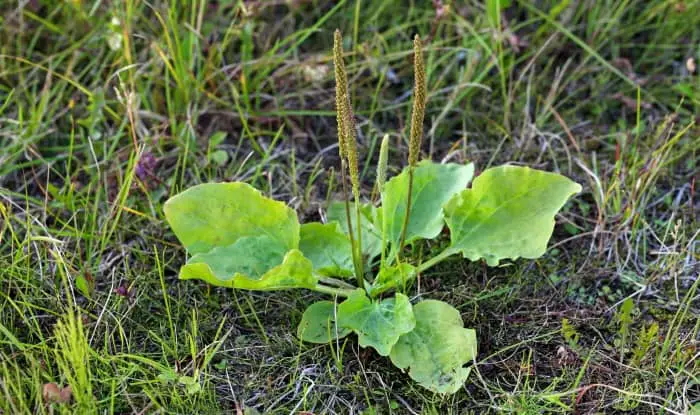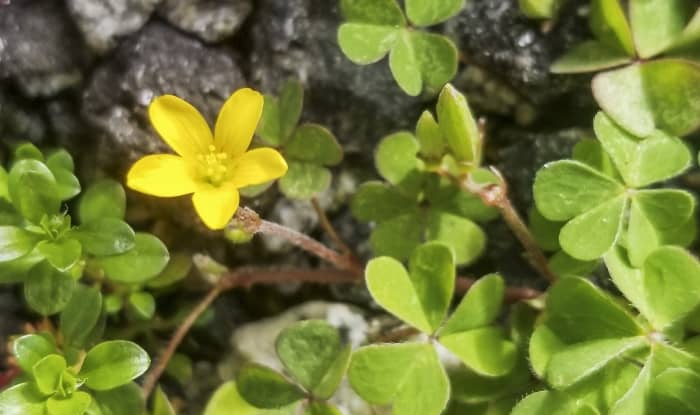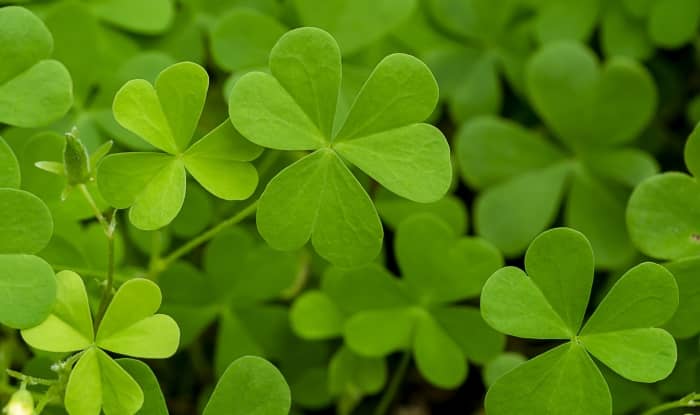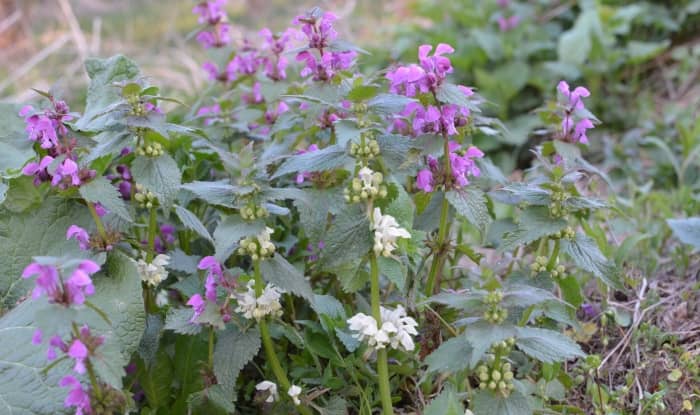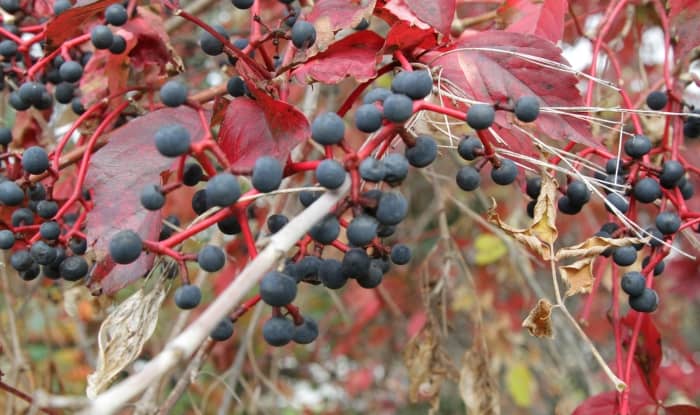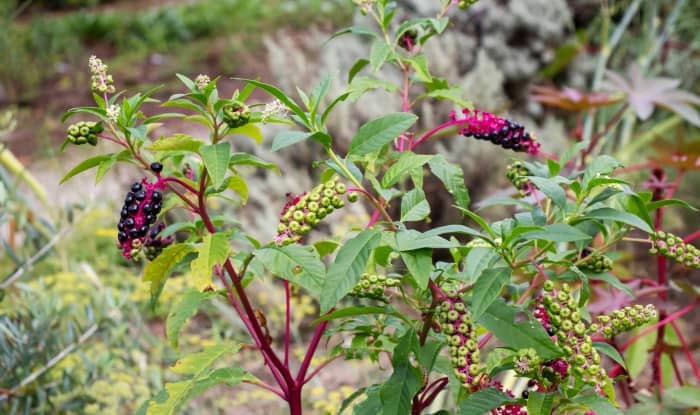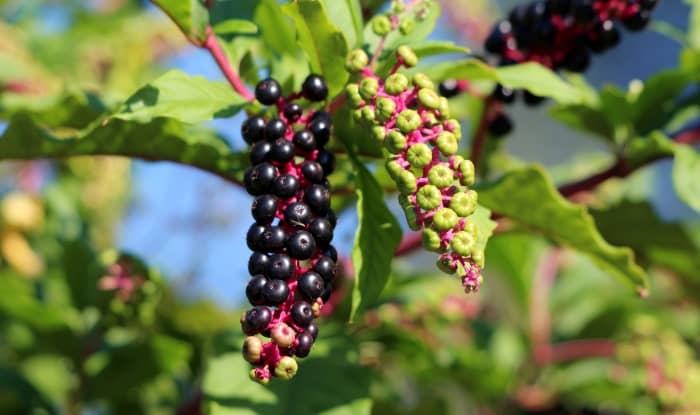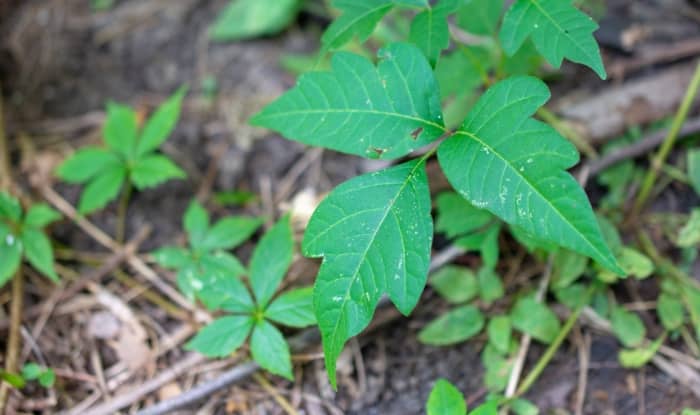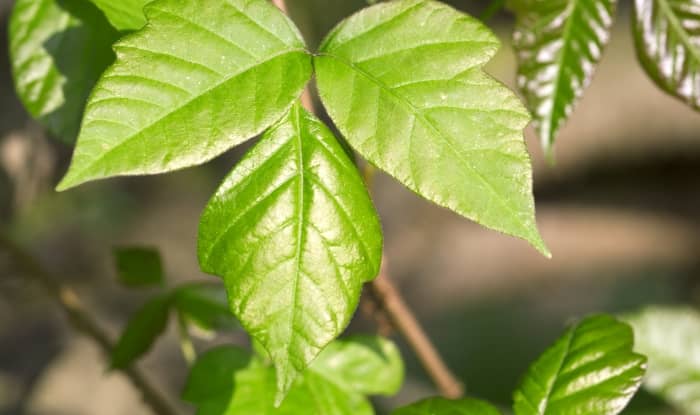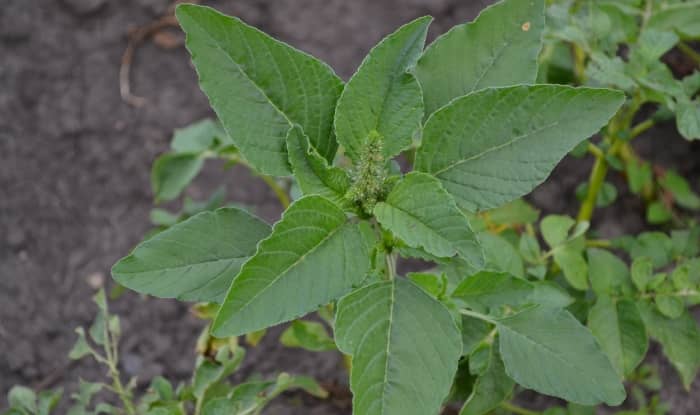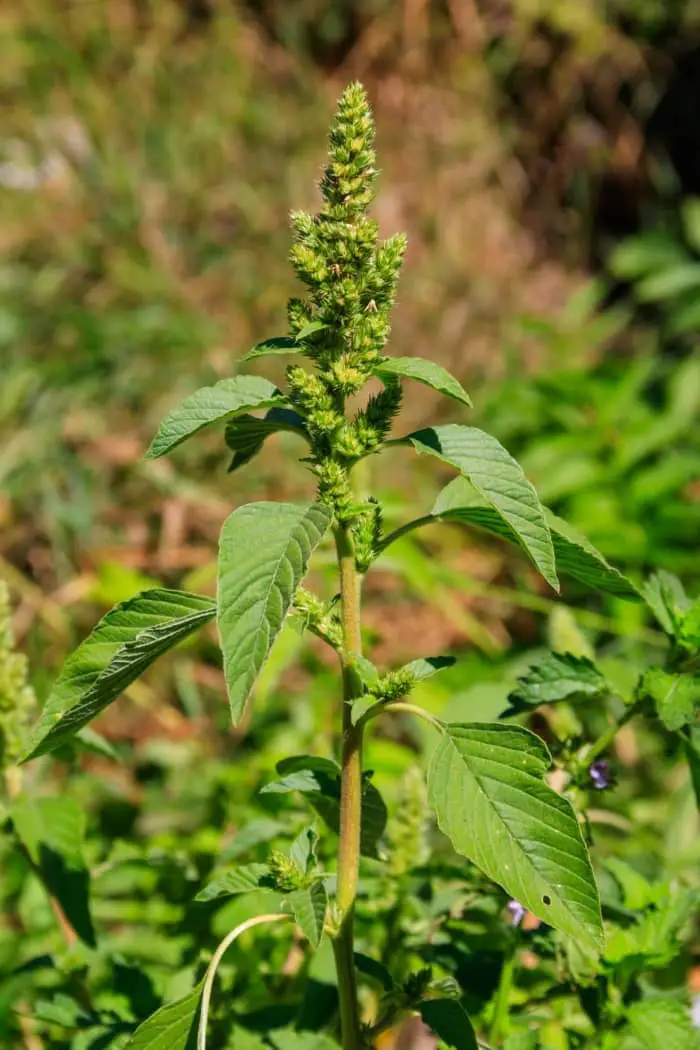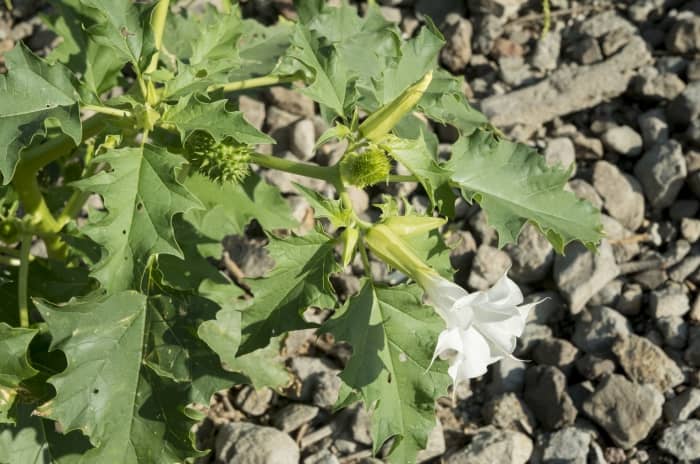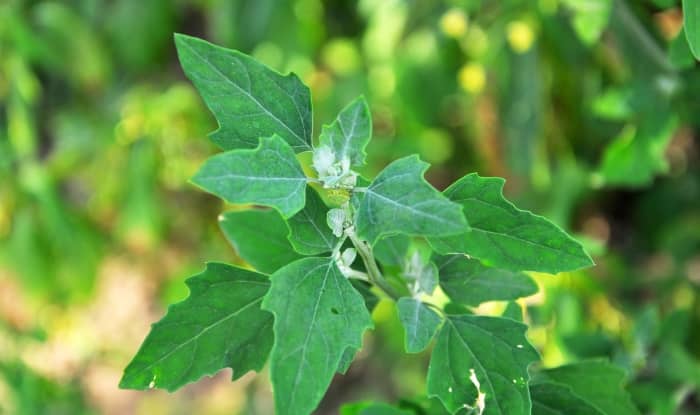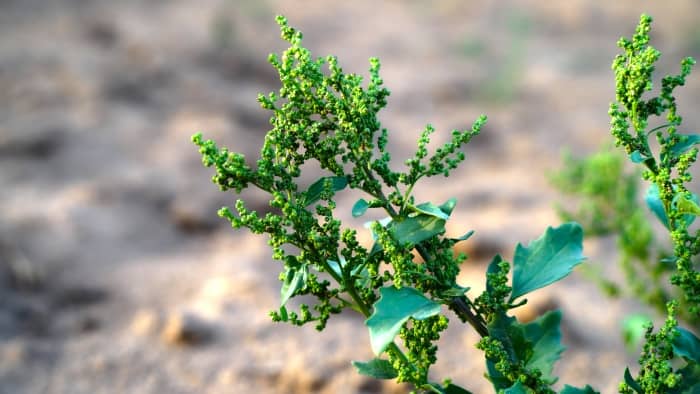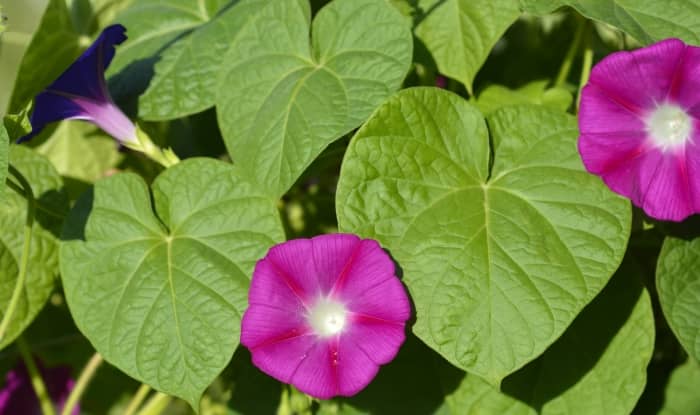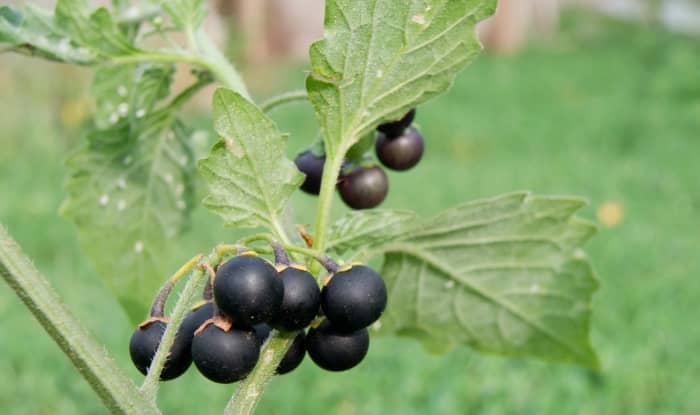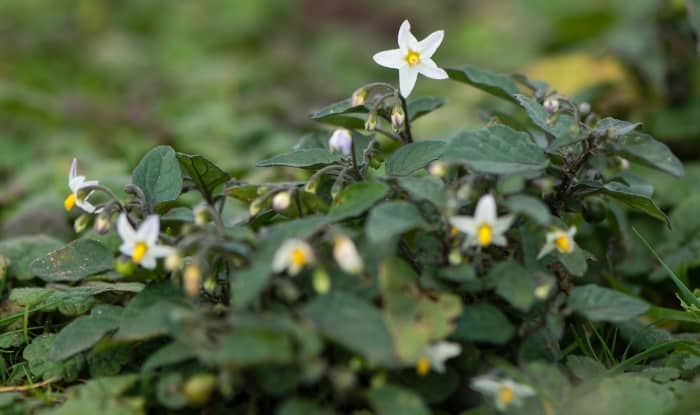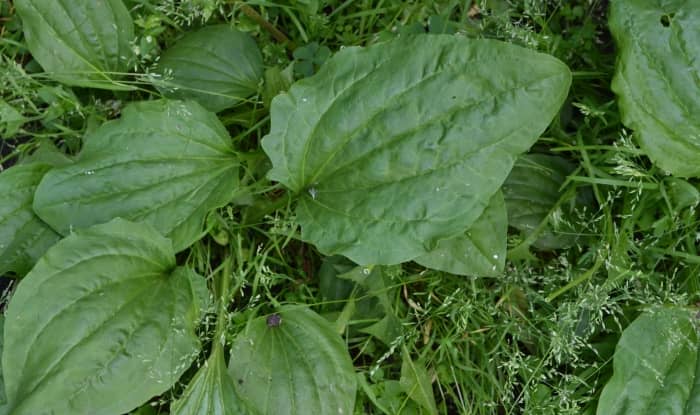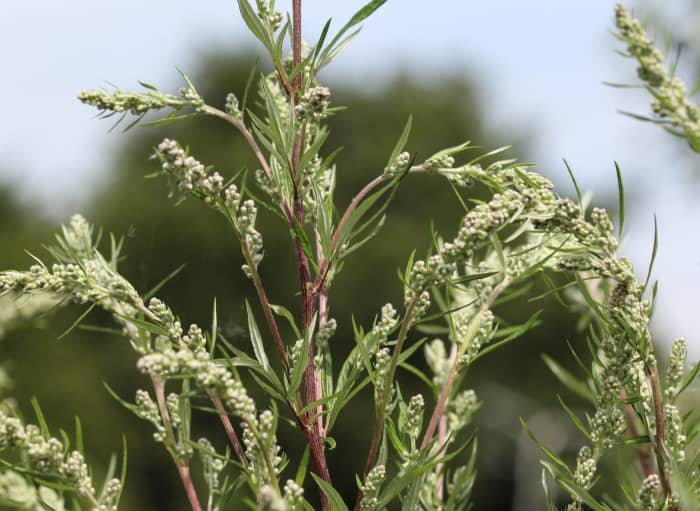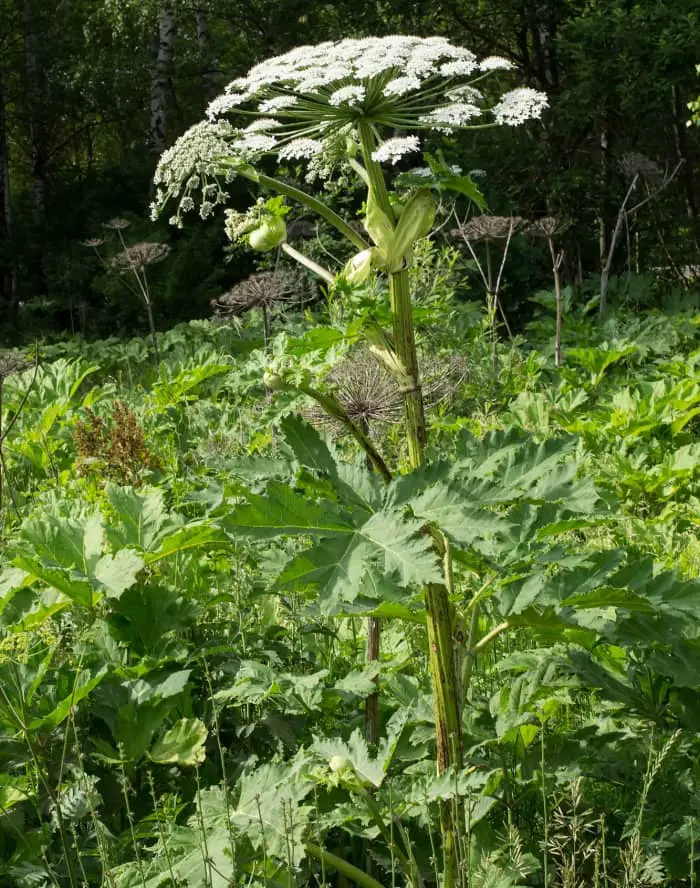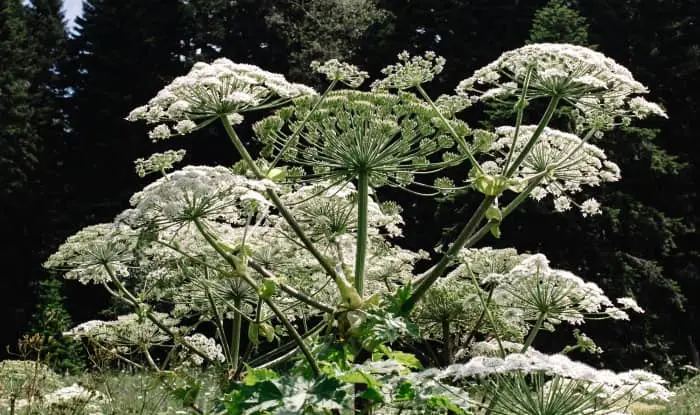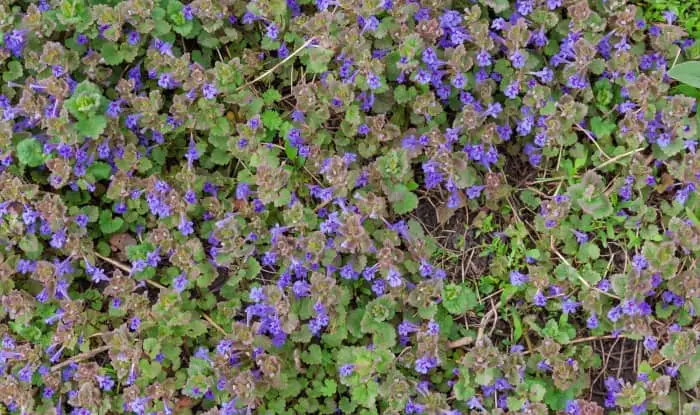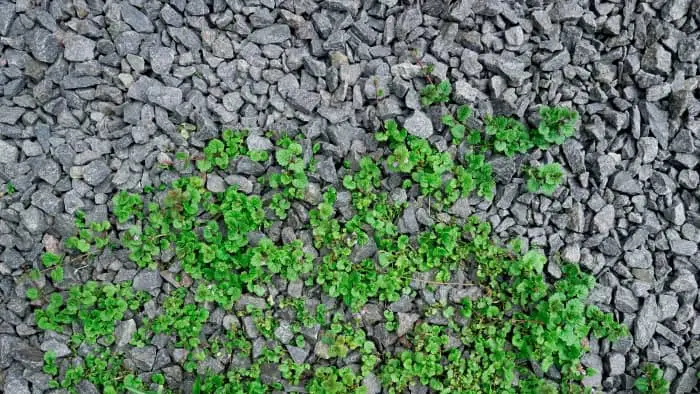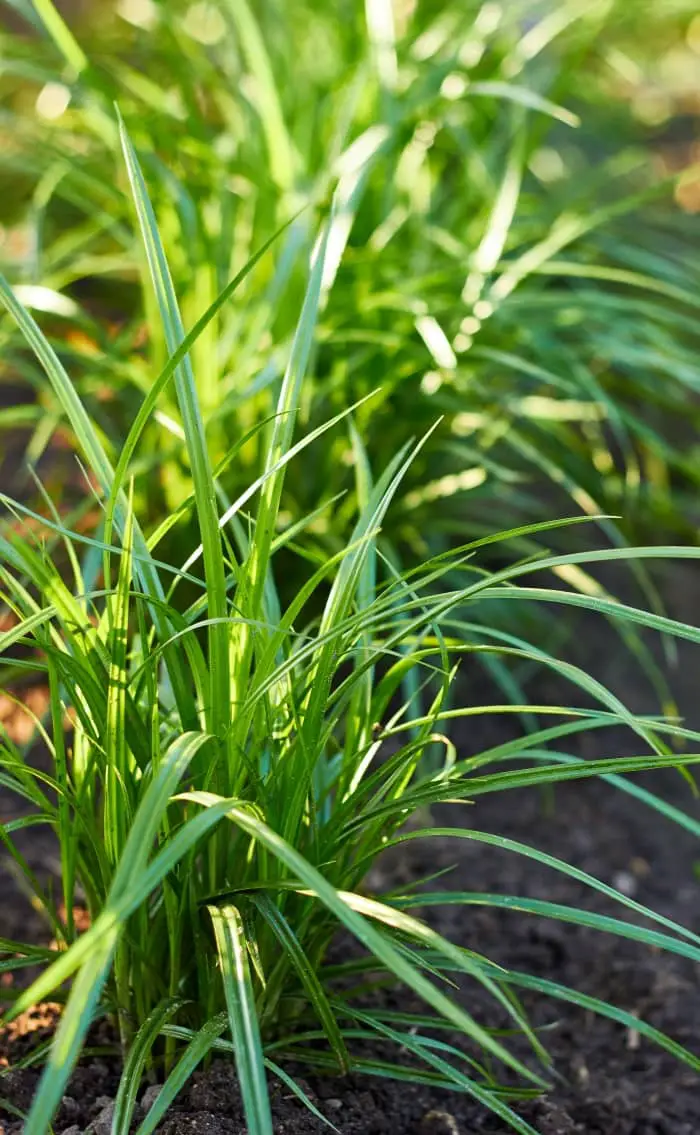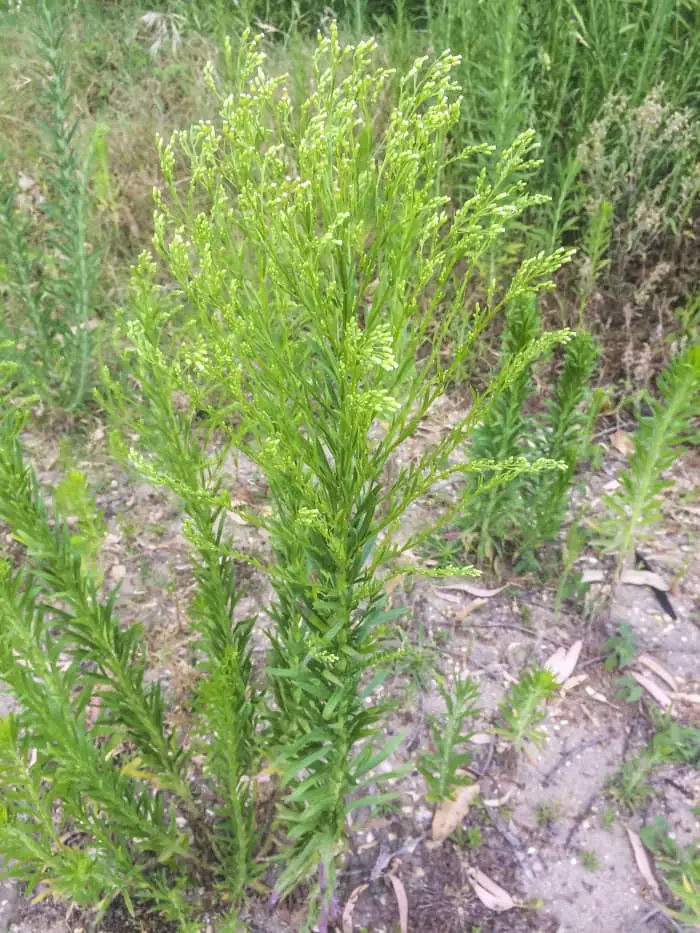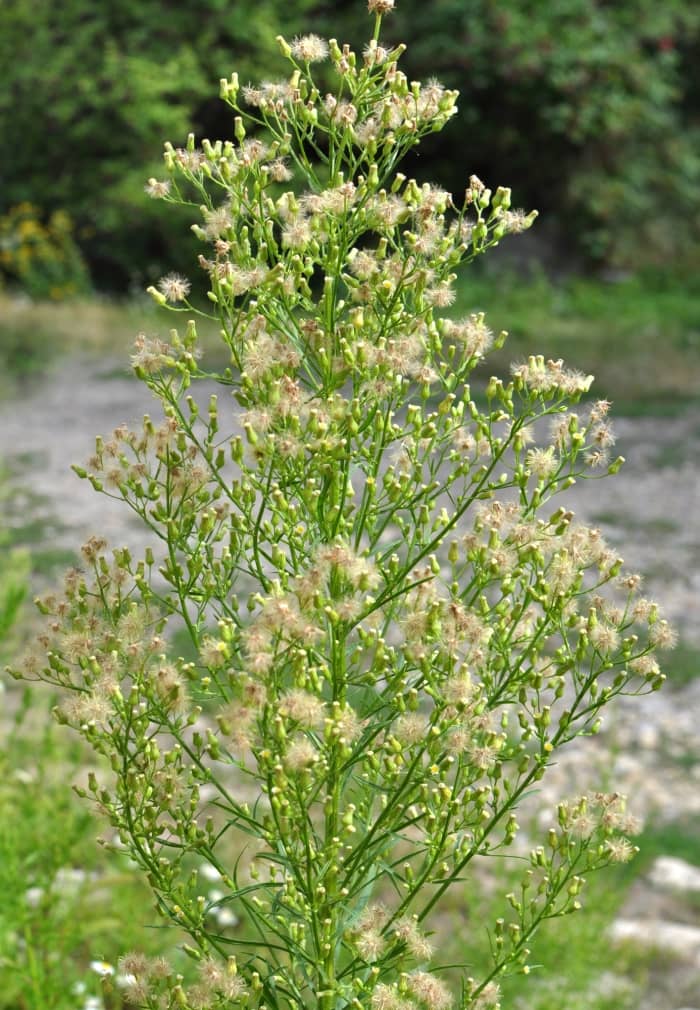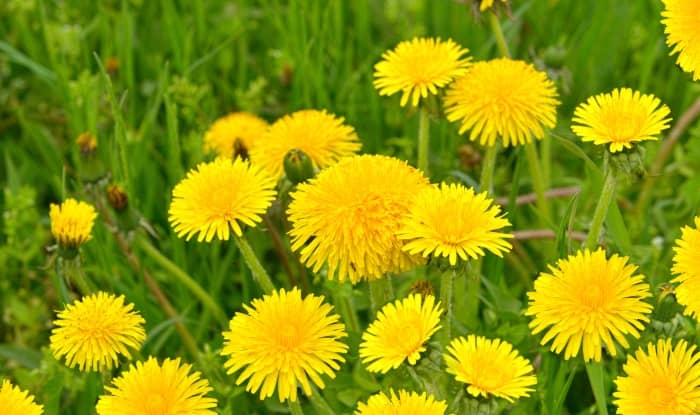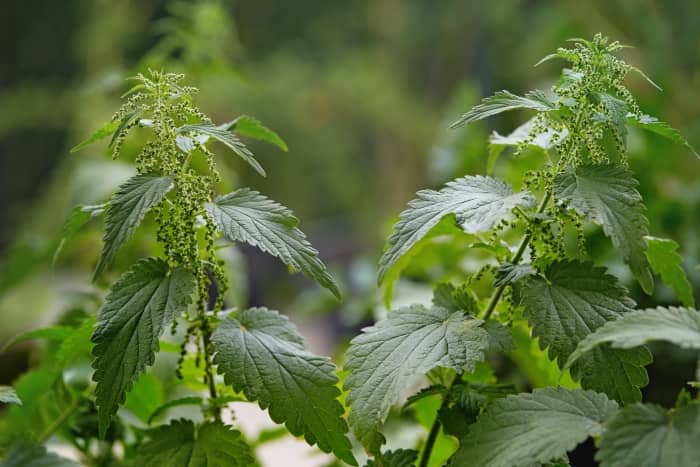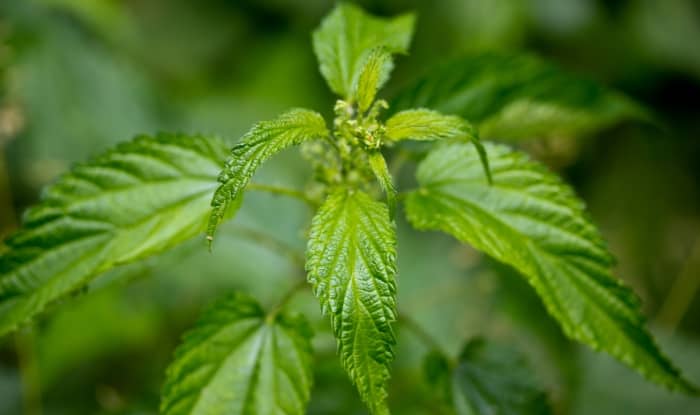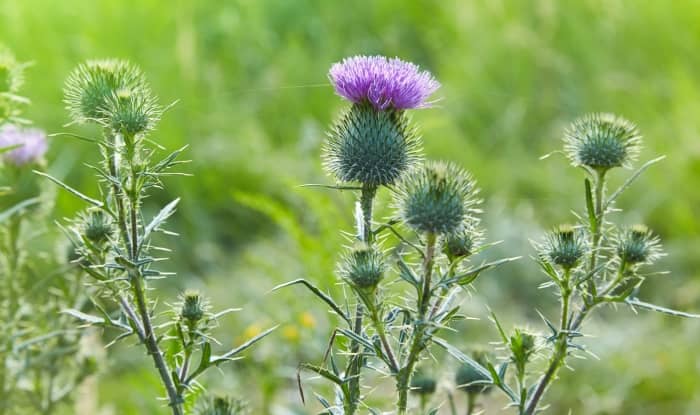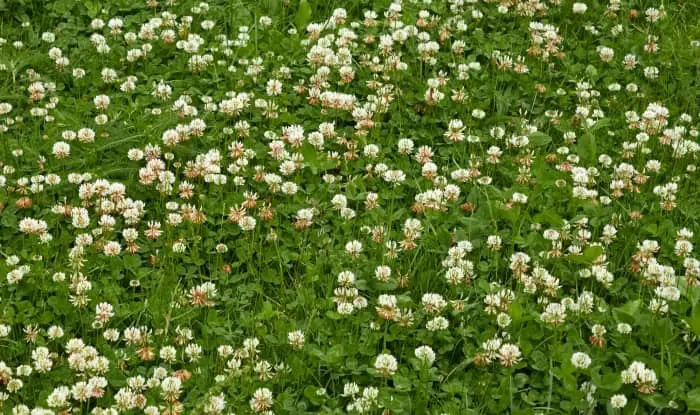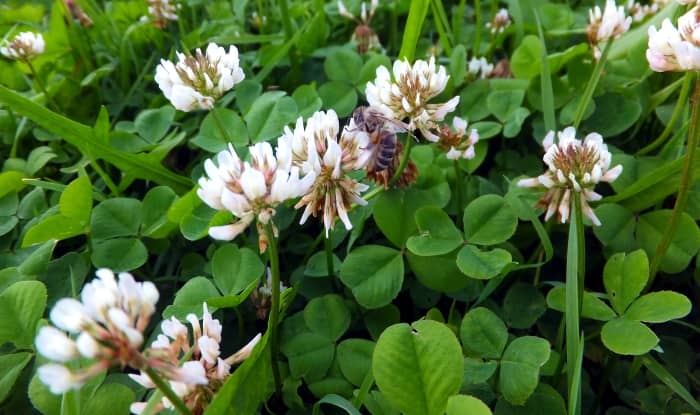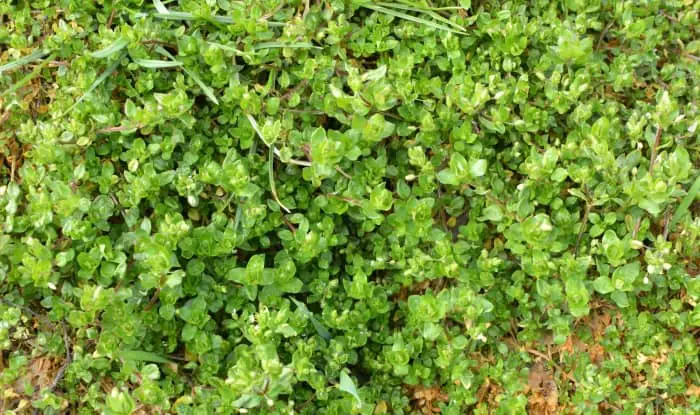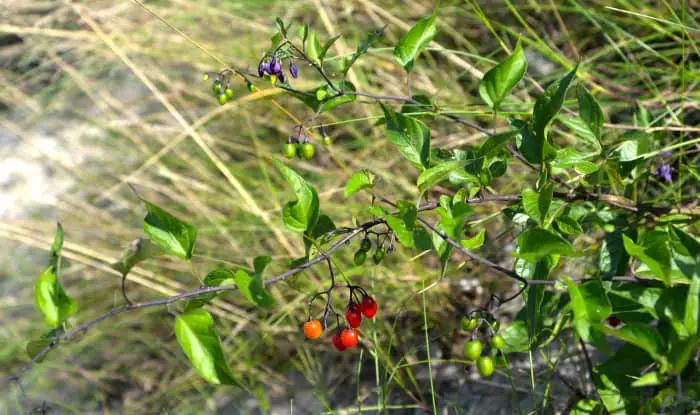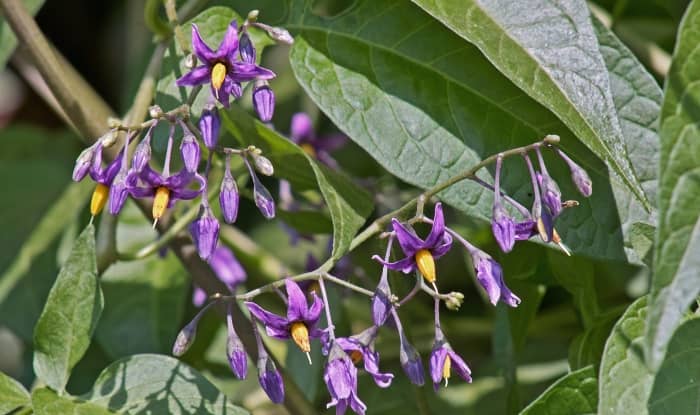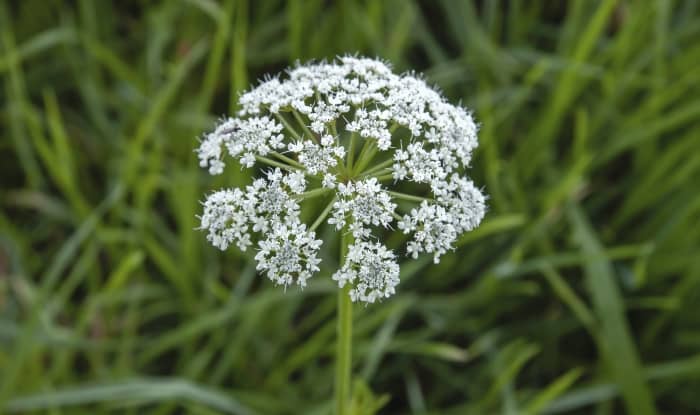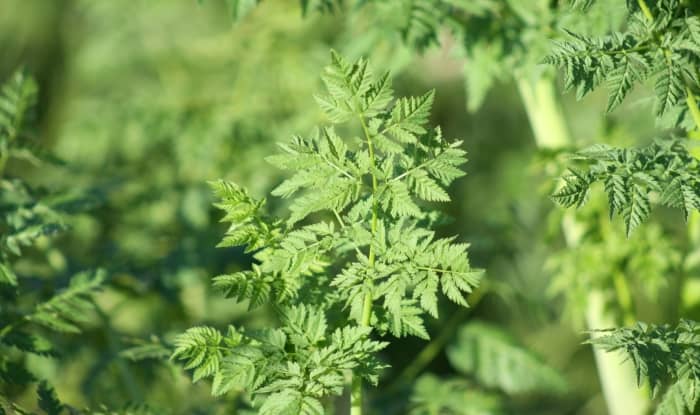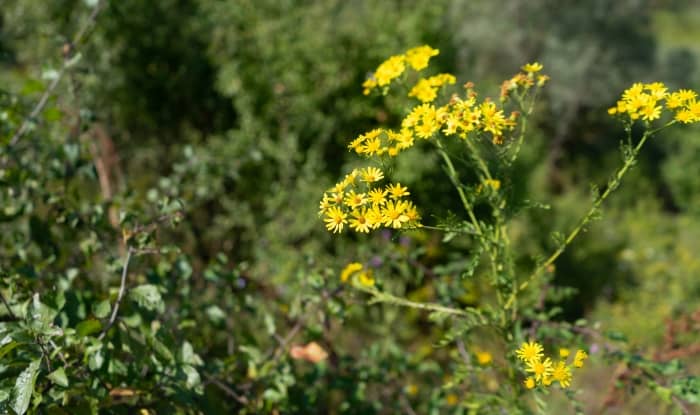Have you found some weeds in New York that you’re trying to identify?
I’ll help you to recognize the most common New York weeds using photos and detailed descriptions.
Let’s dive in.
Common New York Weeds
You can find most of these weeds in New York City, growing in parks and yards, through sidewalk cracks, and along roadsides. And all of them grow in New York State.
You can also find many of these weeds growing throughout northeastern United States.
Creeping Wood Sorrel (Oxalis corniculata)
Creeping wood sorrel is a low-growing plant that resembles a clover weed. This is because wood sorrel has a similar trifoliate leaf, consisting of 3 heart-shaped leaflets. The weed has light-green to purple-red stems and grows from 2-8-inches tall, spreading through horizontal stolons that creep above and below the ground.
When creeping sorrel blooms, it produces flowers from stem tips and leaf axils, either individually or in small groups of 2-5. Each flower has five yellow petals that are sometimes reddish at the base.
Creeping wood sorrel is a weedy wildflower that spreads aggressively in the right conditions, preferring full or partial sun and disturbed areas of loose, fertile soil.
Purple Deadnettle (Lamium purpureum)
Purple deadnettle is a winter annual broadleaf weed that you’ll often find in moist areas such as drainage ditches, the edges of woodland, or shady lawn areas with poor drainage. Purple deadnettle is an aggressive grower, and in the right conditions, the weed quickly spreads.
Purple deadnettle has distinctive square, reddish-green stems. At the top of the stems are small pink-purple flowers. The weed leaves are heart-shaped or triangular with gently scalloped edges and sparsely covered with fine hairs.
Purple deadnettle is usually a low-growing plant, although sometimes it grows up to 10-inches tall.
Henbit (Lamium amplexicaule)
Henbit bears a resemblance to its close cousin purple deadnettle. Like purple deadnettle, henbit has a square stem and pink-purple flowers. But henbit flowers have a longer tube than those found on purple deadnettle.
Henbit leaves are egg-shaped, grow in opposite pairs, and have deeply scalloped edges attached to a deep red stem. Depressed veins on the upper leaf surface make the leaves look wrinkled. The upper leaves are green and attached directly to the main stem, with the lower leaves attached to petioles. In contrast, purple deadnettle has purple-tinged upper leaves connected to petioles.
Like purple deadnettle, henbit likes to grow in moist, fertile soil, and full to partial shade. Henbit is a winter annual broadleaf weed that blooms in the spring before disappearing in May in NY as temperatures climb.
Virginia Creeper (Parthenocissus quinquefolia)
Virginia creeper is a perennial woody vine weed often found around orchards, vineyards, and gardens.
Virginia creeper is a fast-growing vine that’s sometimes mistaken for poison ivy. But unlike poison ivy, Virginia creeper has five leaflets making up its compound leaves that taper to a pointed tip with saw-toothed edges. And Virginia creeper doesn’t produce urushiol oil, the skin irritant that poison ivy is notorious for. But it does produce sap that causes a skin rash in highly sensitive people (1).
Virginia creeper grows well in full sun to full shade and can climb up to 30 ft. with adhesive pads at the end of tendrils holding the vine in place. When Virginia creeper blooms, it produces clusters of yellow flowers at the end of green-red stalks. In the fall, Virginia creeper leaves turn red, and the flowers give way to dark blue-black berries at the end of the now bright red stalks. The berries are poisonous, so don’t eat them.
Pokeweed (Phytolacca Americana)
Pokeweed is a large and problematic perennial broadleaf weed. Pokeweed is an invasive weed because it can spread rapidly in an area, growing in dense, tall bushes that crowd out and displace other plants.
You can easily identify pokeweed when it bears fruit. Pokeweed has attractive, dark-purple berries that are tempting to eat, but make sure you don’t. Pokeweed berries are poisonous.
The fruit contains seeds that help the weed to spread. So even if you don’t remove the plant, it’s worth removing the fruit, especially if you have young children who might put the berries in their mouths.
When pokeweed isn’t producing fruit, you can recognize the weed by its thick hollow red stems, green-white flowers, and large green leaves with long petioles.
Poison Ivy (Toxicodendron radicans)
You can find poison ivy growing as a climbing vine, a shrub, or a groundcover. The vine has reddish stems and leaves that grow alternately, each leaf consisting of 3 leaflets. Young poison ivy plants often have reddish leaves in the spring that turn green in the summer. You can find poison ivy growing in shady and sunny areas of your yard, with vines that sometimes reach 100 ft.
Be careful when handling poison ivy. It’s a noxious weed that contains an oily resin called urushiol that causes a rash if it gets on your skin (2).
Redroot Pigweed (Amaranthus retroflexus)
Redroot pigweed is a summer annual broadleaf weed common in agricultural land and disturbed areas, such as ditch banks and roadsides. But you can also find redroot pigweed encroaching on gardens and landscaped areas. The weed usually grows up to 4 ft. tall, but with plenty of sunlight and little competition, it can grow much taller.
Redroot pigweed takes its name from its thick, red taproot. But the lower stems of the weed are also red. The upper plant stems are hairy with lance-shaped leaves growing from leaf stalks. Egg-shaped leaves grow from the lower plant stems. The leaves grow alternately along the stem, have prominent veins, and are often reddish underneath.
The weed blooms from early summer through to the first frost, producing clusters of inconspicuous green flowers densely packed along the branches and in spikes at the end of stems.
There are many similar pigweed species that can also be found in NY.
Jimson Weed (Datura stramonium)
Also known as thorn apple and devil’s snare, Jimson weed is an invasive weed and a member of the nightshade family.
Because it’s a summer-annual weed, Jimson weed grows at the same time as your crops, using up nutrients that your plants need for growth. And it produces alkaloids that can prevent nearby plants from growing.
Jimson weed produces a large fruit encased in a spiky capsule. But be careful not to eat it. Jimson weed is a well-known poisonous weed that’s dangerous when ingested. And just touching the plant can cause a rash.
Jimson weed is a large weed that grows up to 6.5 ft. tall. The leaves have wavy margins and toothed edges and grow alternately from green stems that are sometimes purple-tinged.
The plant blooms in summer. With trumpet-shaped violet or white flowers up until the first frost.
Lambsquarters (Chenopodium album)
Also known as white goosefoot, lambsquarters is a common summer annual broadleaf weed in the US and Canada.
You can identify this weed by its velvety leaves that have a covering of wooly hairs. The leaves are small, gray-green in color, and triangular-shaped to lance-shaped with wavy edges. The weed grows from several inches to 5 ft. tall with a single central stem that sometimes has side stems.
The plant usually blooms from July to September, with clusters of tiny yellow-green flowers at the end of the stems. Occasionally lambsquarters blooms early in the season.
In the past, lambsquarters was grown for its edible and highly nutritious leaves. But the practice has fallen out of favor due to the viral diseases the weed harbors.
Lambsquarters spreads by seed after the plant flowers in late spring or early fall, so try weed removal before then. It’s fairly easy to pull lambsquarters out of the ground as it only has a short taproot.
Morning Glory Vine (Ipomoea)
The name morning glory refers to a number of closely related plants, many of which are summer annual broadleaf vines. Morning glory spreads through seeds and regrows yearly but reseeds so successfully that you probably won’t notice.
The plant is well-known for its trumpet-shaped flowers that grow in clusters of 2-5 and come in many colors. You can find morning glory vines with white, purple, pink, blue, red, orange, and sometimes bi-colored flowers. The flowers bloom from June to November.
The leaves grow alternately along the vine and are usually heart-shaped. The leaves grow 3-5 inches long and are sometimes glossy.
Morning glory vines rapidly spread in hot weather. A mature plant can quickly grow vines 15 ft. tall, with the stems twisting around each other to strengthen and support the plant’s growth.
Some people like to plant morning glory as a groundcover or aesthetic enhancement for fences and barriers. But because it grows fast, morning glory can quickly become an invasive vine, spreading into yards nearby, growing over all surfaces, and harming plants.
Once established, morning glory can be very hard to get rid of, often requiring the use of powerful chemicals to kill the weed.
Black Nightshade (Solanum nigrum, Solanum ptycanthum, Solanum americanum)
There are three closely related plants called black nightshade in New York State, sharing similar characteristics:
- European black nightshade (Solanum nigrum), also called blackberry nightshade, is native to Eurasia and an introduced species in other parts of the world.
- American black nightshade (Solanum americanum), also called glossy nightshade, is native to the Americas, Melanesia, and Australia.
- Eastern black nightshade (Solanum ptychanthum), also called West Indian black nightshade, is native to North America. This weed grows in all US states apart from Oregon, Nevada, California, and Washington State. You can also find it growing in the southern provinces of Canada.
The black nightshades are broadleaf, annual weeds with small black-purple berries that grow in clusters. The weeds have leaves that grow alternately on short stalks.
Some strains of black nightshade are poisonous plants, while others are edible weeds. The plants also resemble deadly nightshade, so unless you know what you’re doing, make sure you don’t eat the juicy berries or other parts of the plant.
You’ll often find black nightshade growing in cultivated areas, where it competes with crops and causes problems with the harvest.
Broadleaf Plantain (Plantago major)
Broadleaf plantain is also called white man’s foot – a name given to it by Native Americans who associated the plant with the settlers.
It’s a perennial broadleaf weed often seen around farmland and other areas of disturbed soil and a common garden weed.
You can recognize broadleaf plantain by its big leaves that grow in a rosette. Flower stems grow vertically from the center of the weed and feature clusters of tiny greenish-brown flowers at their tips that bloom from June to September. The leaves are oval-shaped, smooth, and grow up to 20 cm long.
You can eat the highly nutritious leaves of broadleaf plantain. But think carefully before allowing this weed to grow in your garden. Each plant produces up to 20,000 seeds. And they can survive in the soil for a long time. So even after you get rid of the plant, plantain will keep appearing in your yard for many years.
Common Mugwort (Artemisia vulgaris)
Mugwort is a sprawling perennial weed regarded as one of the worst weeds by the American nursery industry (3).
Mugwort is a common sight in NYC, growing beside roads, in empty lots, through sidewalk cracks, and covering overpass embankments.
The weed has elliptical leaves that grow alternately from the stem and can reach 1-2 inches long. The upper side of the leaves are smooth and dark green, and the underside is hairy and light green. The hairs are whitish and give leaf surfaces a silver appearance. When you crush the leaves, they give off a bittersweet aroma similar to sage.
Mugwort blooms between July and September and produces clusters of yellow-green flowers that lack petals. Following the flowers, small brown seeds develop that are dispersed by the wind.
Mugwort is a persistent weed that can be hard to control. The weed is able to tolerate low mowing heights and repeatedly bounces back after attempted removal. Repeated applications of chemical herbicides can sometimes work.
Once established, the weed spreads quickly through an extensive system of underground rhizomes, growing in dense stands that crowd out desirable plants.
Giant Hogweed (Heracleum mantegazzianum)
Giant hogweed is a perennial flowering shrub that originated in the western Caucasus region of Eurasia. Giant hogweed was introduced as an ornamental plant in New York but is now considered a noxious weed that has spread to almost every county in the state (4).
In the right conditions, the plant can grow 18 ft. tall. With a stiff tall stalk that grows up to 10 cm thick and 13 ft. high. When it blooms, you can see multiple clusters of white flowers growing from short stalks up into the air. They grow out from a central point, resembling an umbrella.
A fully grown plant has gigantic, deeply lobed leaves that can grow up to 5 ft. wide.
It’s sometimes mistaken for similar-looking plants such as cow parsnip, woodland angelica, purple stem angelica, lovage, valerian, and Queen Anne’s lace.
But giant hogweed grows much taller than any of these. And the stalk has reddish-purple spots and coarse bristles. None of the lookalikes have both of these.
You should wash your hands immediately if you touch hogweed. The watery sap is phototoxic and can cause serious burns if you expose your skin to sunlight.
Creeping Charlie (Glechoma hederacea)
A common nuisance in gardens, if you’ve got a purple-flowered weed growing in your lawn then there’s a good chance that this is the culprit.
Also called ground ivy, creeping charlie is a common broadleaf weed that can quickly take over your yard if you leave it.
It grows low to the ground, usually about 1 inch high, and quickly forms a dense mat of leaves and stems as it spreads.
Other distinguishing features that can help you identify it include a square stem and bright green leaves with scalloped edges, either kidney-shaped or round.
Leaves grow in opposite pairs on either side of the stem attached to a node. And you can see the blueish-purple flowers along the stem when it blooms in spring.
It’s important to know that creeping charlie finds it easiest to colonize lawns that aren’t well cared for. So to keep it away it’s a good idea to regularly mow, fertilize, and water your lawn to help it grow thick and strong. Leaving no room for weeds to become established.
The weed spreads by runners, rhizomes, and seeds. And it can be difficult to get rid of. Because even after you dig creeping charlie out of the soil, leaving any part of the rhizomes behind allows the plant to regrow.
If you catch small patches of the plant early in the spring, then it can be worth having a go at hand pulling it. But this often takes a number of attempts to completely eradicate the plant.
Nutsedge (Cyperus rotundus)
YELLOW NUTSEDGE WEED BY HOMER EDWARD PRICE, CC BY 2.0
Before it blooms, nutsedge resembles tall grass. But there are some distinctive differences when you look closely
To start with, nutsedges are V-shaped. And they’re usually thicker and stiffer. With leaves in a set of 3, rather than the set of 2 commonly seen on grass.
Yellow nutsedge produces golden-yellow flowers and seeds. And purple nutsedge produces red-brown flowers when they bloom, and dark brown or black seeds.
It’s a perennial weed that spreads by seed, underground rhizomes, bulbs, and tubers. Each tuber has the capacity to create hundreds of shoots in a 3-6 ft. area. As well as forming 100+ new tubers.
This makes nutsedge one of the worst weeds to control. The key is to stop nutsedge from establishing itself, as once it does, it’s difficult to get rid of.
Horseweed (Erigeron canadensis)
Also called mare’s tail, horseweed is a summer annual that’s a common landscape and agricultural weed. It’s a tall weed with hairy leaves that develops a single hairy stem that can reach 6-10 ft. in height.
The long, narrow leaves grow alternately from the stem without a petiole and are irregularly toothed.
At the very top of the weed the stem branches and produces small, white daisy-like flowers when in bloom. The flowers give way to tiny seedheads from late July to October, similar to those found on dandelions, that are dispersed by the wind. Each plant can produce up to 200,000 seeds.
Common Dandelion (Taraxacum Officinale)
Taraxacum officinale is one of the most common lawn weeds in New York State. You’ll notice them blooming in the spring. Usually, common dandelions grow low to the ground. But they can reach up to 18-inches in height.
Common dandelions have long narrow leaves with toothed lobes. With the leaves growing up to 8-inches long and 1-inch across. It’s common to find that the undersides of the leaves are hairy, which is particularly noticeable at the midrib. But sometimes they’re completely smooth on both sides.
You can identify this type of weed by its bright yellow flower at the end of a hollow stalk. Which turns into a seed puff of small olive-colored seeds.
Taraxacum officinale is an edible weed. You can eat every part of the common dandelion apart from the seeds. And some people use the root to make dandelion tea.
Stinging Nettle (Urtica dioica)
Stinging nettle is a herbaceous perennial weed that everyone has a brush with at some point. And that brush is often painful. Because stinging nettle has large, serrated-edged leaves with stinging hairs that cause a painful rash when touched.
Once you’ve had this unpleasant experience you quickly learn to recognize the sight of stinging nettle leaves. They’re dark green and grow up to 6-inches. Growing oppositely on a green, wiry stem. When the weed blooms in the summer it produces clusters of small greenish-white flowers.
Stinging nettles are an invasive weed in New York State. The plant produces a large volume of seeds. And also spreads through rhizomes. It’s very difficult to eradicate once it becomes established in an area.
Despite being a weed that most people don’t want anything to do with, it also has some use. Stinging nettle is an edible weed. And you can eat the roots, leaves, and stems. Just remember to cook them first. It’s also a medicinal plant with many health benefits.
Bull Thistle (Cirsium vulgare)
Of all the spiky weeds, thistles are probably the most recognizable. Bull thistles have needle-like spines that cover the leaves and stems of the weed up to the pink-purple flowers. They also have spiny bracts that grow beneath the flower head. Be very careful when handling this prickly plant.
Bull thistles are biennial weeds. In the first year, thistles grow a basal rosette. With flat leaves that have big spikes down the middle and at the edges. In the second year, bull thistles develop a tall stem that can reach 7 ft. in height. And subsequently, flower.
You’ll find this prickly weed growing in various conditions and places. But thistles thrive in locations with good sun exposure and rich soil.
White Clover (Trifolium repens)
One of the most common lawn weeds, white clover is a fast and aggressive growing broadleaf perennial.
It’s a creeping plant that spreads low to the ground. And everywhere a stem node makes contact it grows roots.
For identification, take a look at the tear-shaped leaflets that grow in sets of 3, and sometimes show a reddish stripe. And a close look at the spiky small white flowers should reveal a green center.
Chickweed (Stellaria media)
This common annual broadleaf weed is well known for spreading quickly across lawns if left unchecked.
Popular with chickens, hence the name, it’s an edible herb. And you can use the flowers and leaves in a salad after you’ve finished digging it up.
If you’re keeping an eye on your lawn, you’ll first notice chickweed growing during the winter. It likes to grow in moist, cool, shaded areas. And forms a thick carpet as it spreads. With stems extending up to 16-inches from the center of the plant.
In early spring, chickweed blooms. Producing small white star-shaped flowers with 5 petals. Flowering continues until fall.
It reproduces by both seeds and through its roots. And once you allow it to spread across your lawn it’s difficult to get rid of.
Bittersweet Nightshade (Solanum dulcamara)
Also known as poison berry, bitter nightshade, blue bindweed, and climbing nightshade, bitter nightshade is a perennial woody vine that climbs and grows along the ground, reaching up to 10 ft in length. The weed is notorious for its toxicity, with all parts of the plant poisonous.
Bittersweet nightshade has dark green, ovate leaves, that can be purple-tinged. The leaves grow alternately from stiff, smooth stems that are purple to greenish-brown, reaching 2-4 inches long. The plant blooms from May to September, with small flowers that grow in clusters. The flowers have bright purple petals with yellow anthers. In the fall, you’ll see hanging clusters of bright red berries.
It’s common to see bittersweet nightshade growing in gardens, parks, along roadsides, and around field edges and wetlands. The plant likes moist, loamy soil, and full sun to partial shade. In the right conditions, it spreads rapidly through rhizomes and seeds, particularly in areas of disturbed soil.
Poison Hemlock (Conium maculatum)
Of all the weeds to find growing in your garden, this is one of the least welcome. Also known as deadly hemlock, spotted hemlock, and poison parsley, poison hemlock is a noxious weed with a famous reputation for being highly toxic.
All parts of this weed are poisonous when eaten, and even a small amount can be fatal. Be careful when handling the plant as the toxins can cause severe skin reactions, and even dead canes retain their toxicity for up to three years. Besides humans, poison hemlock is poisonous to cats, dogs, sheep, cattle, horses, chickens, and goats.
The plant stems have reddish-purple streaks or spots and are smooth and hollow. The bright green leaves are fern-like with toothed edges and are particularly poisonous in the spring. When poison hemlock blooms, the plant produces clusters of tiny, white flowers with 5 petals. The flowers develop into green fruit.
Poison hemlock is a biennial that usually grows for two years. But in good locations, it’s sometimes a perennial weed. Poison hemlock often grows in open sunny areas. It’s common to see it growing in vacant lots, fields, alongside roads, and at the edge of cultivated land.
Common Ragwort (Jacobaea vulgaris)
Common ragwort is also known by the names tansy ragwort, stinking willie, and St. James’ wort. The plant is native to northern Eurasia, where it’s a common wildflower, but also grows as a weed in New York. You’ll often find ragwort growing in gardens, around waste areas, and on agricultural land.
In the Northern Hemisphere, ragwort blooms from June to November. The weed has bright yellow flowers that grow in flat-topped clusters at the end of long stalks.
Ragwort is usually a biennial weed. Developing a basal rosette of ruffled leaves when the plant first emerges. In the second year, the long, erect stems grow. The stems are hairless. And the weed has pinnately lobed leaves with a blunt end lobe.
The weed is invasive in some areas. Once ragwort becomes established it can be difficult to control. The weed produces thousands of seeds that spread into nearby fields and gardens, enabling the plant to easily spread.
References:
- Virginia Creeper – https://hgic.clemson.edu/weed-of-the-month-virginia-creeper/
- Poison Ivy Dermatitis – https://www.aocd.org/page/PoisonIvyDermatiti
- Mugwort – https://extension.wvu.edu/lawn-gardening-pests/weeds/mugwort
- Giant Hogweed: A Plant That Can Burn and Blind You. But Don’t Panic. – https://www.nytimes.com/2018/07/02/us/giant-hogweed-nyt.html
